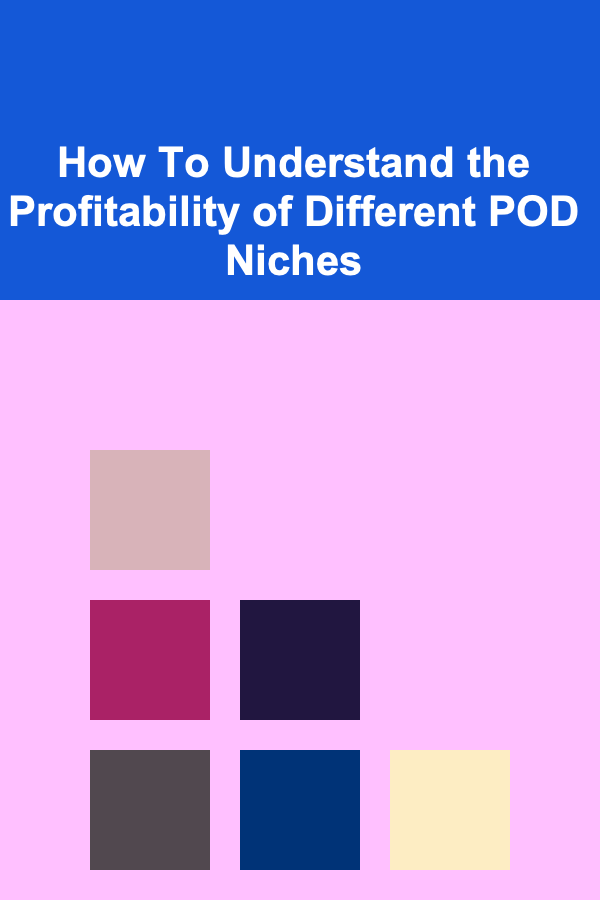
How To Understand the Profitability of Different POD Niches
ebook include PDF & Audio bundle (Micro Guide)
$12.99$9.99
Limited Time Offer! Order within the next:

In the world of Print-on-Demand (POD), profitability is a key factor that drives success. POD offers entrepreneurs the flexibility to sell custom-designed products without the need to keep inventory or manage shipping, making it an attractive business model. However, the success of a POD business largely depends on understanding which niches are profitable and how to evaluate their potential for growth. This article explores the process of understanding the profitability of different POD niches, providing a step-by-step guide to making informed decisions that maximize your chances of success.
What is Print-on-Demand (POD)?
Before diving into niche profitability, it's essential to define what POD is. Print-on-Demand is a fulfillment model where products are printed and shipped only when a customer makes a purchase. POD businesses typically sell custom items like t-shirts, mugs, phone cases, and posters, all of which are designed by the seller. The products are printed by a third-party supplier, who handles the printing and shipping.
This model eliminates the need for upfront inventory costs, as you don't have to buy products in bulk. Instead, you only pay for the products once an order is made. The ability to create unique designs and test out different products without financial risk is one of the major advantages of POD.
The Importance of Niche Selection
Selecting the right niche is one of the most crucial factors in determining the profitability of a POD business. A niche is essentially a specific market segment that targets a particular group of people with shared interests or needs. A well-chosen niche can make your business stand out in a crowded market, enabling you to reach the right customers with the right products.
While it may be tempting to target a broad audience, focusing on a specific niche allows you to build a more dedicated customer base. This is because niche markets tend to have less competition, and your products can appeal to a specific set of customers who are passionate about the niche's unique needs and interests.
The right niche can also help you lower marketing costs, as you will know exactly who your audience is and where to find them. However, not all niches are created equal, and understanding the profitability of different POD niches requires careful research and analysis.
Evaluating the Profitability of Different POD Niches
The process of evaluating the profitability of a POD niche involves several key steps. By considering market demand, competition, customer preferences, and other factors, you can determine which niches have the most potential for long-term success.
1. Market Demand: Identifying Trends and Interests
The first step in evaluating a POD niche is understanding the market demand. A profitable niche should have a substantial audience that is willing to purchase custom products related to their interests. Here are some ways to assess market demand:
- Google Trends: Google Trends allows you to analyze the popularity of specific search terms over time. By entering keywords related to your niche, you can determine if interest in that topic is growing or declining. Look for niches with consistent or rising interest over time.
- Social Media: Social media platforms like Instagram, Pinterest, and TikTok can provide valuable insights into what people are talking about and sharing. By observing trending topics and hashtags, you can spot emerging interests and potential niches.
- Online Communities: Niche forums, Reddit, and Facebook groups are excellent places to gauge the level of interest in a particular subject. Communities that are highly engaged and active are often a sign of a profitable niche.
2. Competition: Understanding the Market Saturation
While a niche with high demand may seem appealing, it's important to consider the level of competition. Highly saturated markets can make it difficult for new POD businesses to stand out, leading to higher marketing costs and lower profit margins.
To evaluate competition, consider the following:
- Research Your Niche: Search for products related to your niche on popular POD platforms like Etsy, Redbubble, and Teespring. Look at the number of sellers offering similar products and analyze the quality of their designs. High-quality designs and large numbers of sellers can indicate strong competition.
- Amazon and eBay: These giant eCommerce platforms can also provide a glimpse into the competition in your niche. Search for the types of products you want to sell and check the number of listings. If you find numerous high-ranking listings for similar products, it may indicate a saturated market.
- Market Differentiation: A niche with high competition doesn't automatically mean it's not profitable. The key is to find a way to differentiate your products. Unique designs, specialized products, or a specific sub-niche can help you stand out in a crowded market.
3. Target Audience and Customer Profile
Understanding your target audience is a fundamental part of evaluating the profitability of your POD niche. A profitable niche should appeal to a group of customers with specific needs, desires, or passions. To understand your potential customers, ask yourself the following questions:
- Who is my target audience? Are they young adults, parents, pet owners, or hobbyists? Understanding the demographics of your audience (age, gender, income, location) will help you design products that cater to their preferences.
- What are their pain points or desires? What problem does your product solve, or what aspiration does it fulfill? For example, if your niche is fitness, your customers might be looking for motivational apparel or accessories to enhance their workout experience.
- Where do they shop? Knowing where your target audience spends their time online can help you focus your marketing efforts on the right platforms. Are they active on Instagram, Pinterest, or YouTube? Are they part of niche communities or influencers' fanbases?
4. Profit Margins and Pricing Strategy
The potential for profitability also depends on your pricing strategy and the profit margins of the products you are selling. POD businesses typically have lower profit margins compared to traditional retail models, as the cost per product is higher due to the print-on-demand model.
To maximize profitability, consider the following:
- Product Costs: Calculate the cost of producing each item, including printing, shipping, and any platform fees. Once you know the cost, you can determine a fair price point that ensures you are making a profit while remaining competitive in the market.
- Pricing Strategy: A common pricing strategy for POD products is to mark up the base cost by 100-200%. For example, if the production cost of a t-shirt is $15, you might price it at $30 or $40, depending on the demand for your design and the niche's pricing trends.
- Customer Lifetime Value (CLV): In niches with strong customer loyalty, such as fan-based merchandise or pet products, customers may return to buy additional items over time. Focus on creating a strong brand that encourages repeat business, increasing your long-term profitability.
5. Niche Longevity: Is It a Trend or a Fad?
Some niches may experience a surge in popularity due to trends or viral moments, but these types of niches can quickly fade as interest wanes. On the other hand, evergreen niches---those with long-term, stable demand---offer more sustainable profitability.
To assess the longevity of a niche, consider:
- Trend Cycles: Is the niche based on a current trend, or is it something that has stood the test of time? For example, seasonal niches (e.g., Christmas-themed products) may be profitable but have limited longevity, while niches focused on evergreen topics (e.g., fitness or pets) tend to have more sustained interest.
- Evergreen Topics: Evergreen niches are those that continuously attract interest. These can include hobbies, lifestyles, or passions that don't rely on short-lived trends. Examples of evergreen niches include fitness, pets, home decor, and self-improvement.
6. Branding and Marketing Potential
Branding and effective marketing strategies are key to making any niche profitable. The more identifiable and relatable your brand is to your target audience, the more likely customers will resonate with your products and make purchases.
Consider the following factors when evaluating the branding and marketing potential of a niche:
- Storytelling: A strong brand story can set your products apart from the competition. Whether you focus on sustainability, unique designs, or a passion for a particular hobby, having a clear and compelling brand message is crucial.
- Influencers and Partnerships: Consider whether there are influencers or communities within your niche that you can collaborate with to promote your products. Influencer marketing can help you quickly gain traction and reach a larger audience.
- Social Media and Content Marketing: Leveraging social media platforms to showcase your designs and engage with your audience is essential for driving traffic to your store. Content marketing, including blog posts, videos, and tutorials, can also help build brand authority.
Conclusion
Understanding the profitability of different POD niches is a multifaceted process that requires research, analysis, and strategic planning. By assessing market demand, competition, customer preferences, profit margins, and long-term viability, you can identify profitable niches with the potential for sustained success. With the right niche and a strong marketing strategy, your POD business can thrive and generate long-term profits in the ever-growing eCommerce market.

10 Smart Ways of Utilizing Community Resources to Save Money
Read More
How to Build a Deep Learning SaaS for Recurring Revenue
Read More
How to Maximize Storage in Tiny Bathrooms
Read More
How to Offer Social Media Advertising Design Services
Read More
How to Date After Divorce
Read More
10 Tips for Mental Toughness in Competitive Tennis
Read MoreOther Products

10 Smart Ways of Utilizing Community Resources to Save Money
Read More
How to Build a Deep Learning SaaS for Recurring Revenue
Read More
How to Maximize Storage in Tiny Bathrooms
Read More
How to Offer Social Media Advertising Design Services
Read More
How to Date After Divorce
Read More